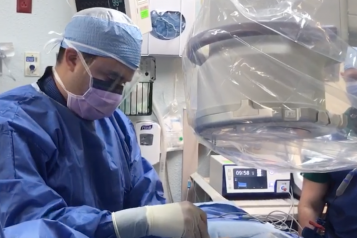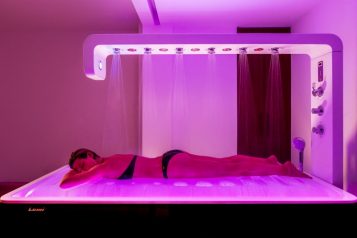
Double board-certified plastic surgeon and Harvard Medical School Associate Professor of Surgery, Dr. Samuel Lin has acquired state-of-the-art skills in several reconstructive and cosmetic procedures. After editing several medical textbooks and being awarded the American Association of Plastic Surgeons (AAPS) Academic Scholar Award, it’s clear that Dr. Lin is pioneering his field one patient at a time. Dr. Lin sat down with Haute Beauty to discuss which procedure he’s best known for, and his most memorable patient reaction.
My greatest achievement is?
The fact that after graduating from medical school in 1998 and completing two surgical residencies and fellowship, years later I am still at my first job as a double board certified plastic surgeon at Harvard Medical School. I had no family, educational, or personal ties to Boston but was drawn to the area due to its rich medical history, world class culture, and cutting edge innovation. The area is saturated with extremely knowledgeable and brilliant scientists and clinicians, and I am still in awe of the sheer productivity of the area, not to mention, lately, sports championships. Nonetheless, it is an extremely and can be a daunting, competitive landscape for a new surgeon. However, I have found a willingness from colleagues to collaborate and work together. Although Boston has likely one of the highest densities of physicians, I believe that always doing right by the patient is the best way to build a practice, and it is hard to believe the years that have gone by. I am proud of what my practice has become and my research team has accomplished over the years. In my practice, I take care of patients both locally and internationally.
The future of my field is?
The continued development of minimally invasive or noninvasive cosmetic procedures. Today, many patients seek a shorter recovery so that they can get back to their lives. There are a whole host of devices and treatments that tighten, contour, and smooth the body and face. On the research side, the implementation of three-dimensional printing technology may continue to develop. In plastic surgery, 3D printing has been used primarily for education, modeling, and planning. This entails printing out a model of a certain body part to gain a better understanding of how it can be modified to achieve the best possible surgical outcome. This is of great impact in resident trainee education, preoperative surgical planning, and most importantly optimizing the results surgery. The future of this technology may see the development of implants to be used in different parts of the body. Furthermore, this may be of benefit in the realm of limb salvage where prosthetic limbs can be produced more cost effectively.
The biggest misconception about my field is?
Its focus primarily solely on cosmetic surgery. Although a wide variety of cosmetic procedures do exist and are popularized by the media, some individuals may tend not to realize the reconstructive portion of my specialty. Plastic surgeons are heavily involved in reconstruction of defects following cancer resection or trauma. This includes the head and neck, breast, and extremities. In addition, plastic surgeons are involved in the treatment of facial fractures, pediatric anomalies in children, disease of the hand, and lymphedema. In accomplishing these reconstructions, we attempt to restore form and function. These efforts span all ages, races, and gender.
My most requested procedures?
Are rhinoplasty (functional and aesthetic nose surgery), face/neck lift procedures, body contouring, and breast surgery (reduction, lift, reconstruction) procedures. Rhinoplasty (commonly referred to as a nose job) is the art of enhancing the shape of the nose and may involve improvement of the breathing. Rhinoplasty can be done by open or closed approach according to the degree of nasal deformity and the corrections needed to be done. I enjoy taking care of a variety of patients who have had prior surgeries for rhinoplasty revisions as well. Body contouring can involve liposuction of the abdomen or arms/legs or removal of skin/fat from different areas.
What surgical advancements are you most excited about?
Recent improvements in plastic surgery have been swift with the emergence of numerous new and exciting techniques. Reconstructive procedures have developed due to a greater understanding of the anatomy of the blood supply to skin and muscle, with the subsequent expansion of different innovative treatments using tissue manipulation. With the advent of microsurgery, we are now able to transfer tissue from one part of the body to another which in itself has revolutionized breast reconstruction, and life altering procedures such replantation of amputated parts. We have also witnessed advacements in the treatment of hand injuries and chronic diseases such as arthritis for which we now have replacement joints. Craniofacial surgery has enabled us to employ techniques for the treatment of various facial deformities both in adults and children. Additionally, newer recovery time strategies in plastic surgery have arrived which may continue to benefit future patients and allow faster recovery such as enhanced recovery protocols (ERAS) for outpatient cosmetic and reconstructive surgery.
What are you best known for?
Rhinoplasty and breast reconstruction. The nose is perhaps the most noticeable part of the face, due to its central location. Minor deformities and irregularities are very difficult to hide or camouflage and are more eye-catching than any other area of the face. Nasal proportions should be in harmony with each other and with the rest of the face and body features. As such, patients may seek a rhinoplasty procedure.Additionally, I am able to reconstruct a patient’s breasts after cancer treatment with three different techniques: deep inferior epigastric perforator (DIEP) flap breast reconstruction, latissimus dorsi flap reconstruction, and implant-based reconstruction.
What is your most memorable patient reaction?
I have to say that one of my greatest surprises was when I was seeing a patient in consultation. During consultations I invariably talk about what a patient’s job or interests are in order to get to know someone. During one visit I asked a patient who was interested in a tummy-tuck and breast augmentation/lift procedure a follow up question on their patient intake form, which listed “Princess” under occupation. To my complete surprise, indeed, she ended up being a member of a royal family who was trying to be discrete about her background! I performed her surgery and she did great; subsequently she and her travelling/security staff of 30 went back to their country.
Separately, I enjoy also helping patients through the breast cancer reconstruction phase with quality of life and satisfaction of reconstructed breasts after having gone through chemotherapy and radiation treatment for breast cancer treatment and failed reconstruction. One such patient had been combating breast cancer for 2 years. During that time, she underwent chemotherapy, radiation, a bilateral mastectomy, and implant-based reconstruction. She subsequently developed an infection in one for her breasts and had to have her implant removed. She was told by her original surgeon that she would require a TRAM (transverse rectus abdominis muscle) flap to salvage her reconstruction. However, in doing her research, she found that this would entail sacrificing her abdominal muscles with the possibility of developing a hernia. She was referred to me at which point I offered to perform a DIEP (deep inferior epigastric perforator) flap which would spare her abdominal muscles. Per the patient “I do not know how I could ever possibly show my gratitude to Dr. Lin and everyone at his office! They made me whole again, physically and emotionally! Dr. Lin and his staff made me feel like I was their only patient! He really is the best!” I was simply humbled by her comments and so happy that her life was significantly improved.
What sets my practice apart is?
Being board certified in two fields allows me to have a perspective regarding providing the highest standards of care to my patients. Plastic surgery is a process that involves the patient along with the physician in deciding the best course of treatment. I am a full-time member of the academic staff at my hospital/Harvard Medical School and in national organizations for plastic surgery. This interface allows me to interact with plastic surgery leaders around the country in understanding the latest techniques in plastic surgery and my colleagues’ collective experiences.Safety, sterile techniques, and infection control is of the highest importance. We strictly maintain national sterilization and safety standards at all times.I am committed to giving patients the best possible service and results. Furthermore, I am committed to continued medical education. I regularly give talks at plastic surgery meetings and attend conventions to stay informed of new techniques, the latest products, and the newest equipment that a modern plastic surgery practice can utilize to provide state-of-the-art cosmetic enhancement procedures. Also, being a member of various professional plastic surgery organizations helps me to stay current of the changes and recommendations of our profession.Considering plastic surgery can be a very personal decision, and my team is committed to providing you with excellent care while addressing a patient’s specific needs.
What I love most about my profession is?
The impact I can have on patients’ lives with providing carefully planned plastic surgical care. Despite recovery time and other individual circumstances patients are usually very grateful at the conclusion of their journey. The ability to make them feel whole again and enable them to have a new lease on life is always gratifying. In addition, I enjoy the detail and artistry that comes with plastic surgery. No two operations are the same since no two people are the same. I can be innovative in my approach to surgery and work on different parts of the body, all in one case.
What new services are you excited to offer?
I am always excited to offer the latest in time-tested plastic surgery techniques in face/nose and breast/body surgery. The field continues to improve, and I am happy to be a part of the forefront.From newly designed patient reported outcomes tracking to new biomaterials for plastic surgery patients, my team and I are constantly working to contribute to our patients and to science. One new service is our latest preoperative imaging service that we can provide to our patients.
For more information, visit Dr. Brian A. Levine's social media:

























